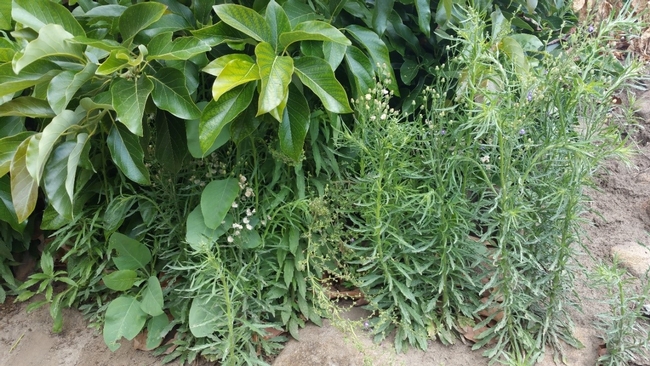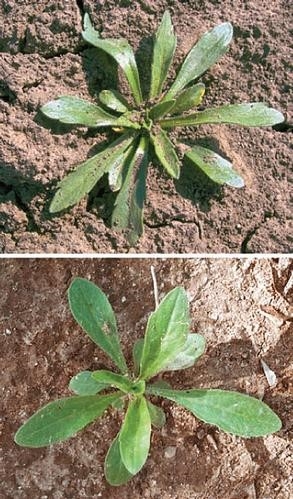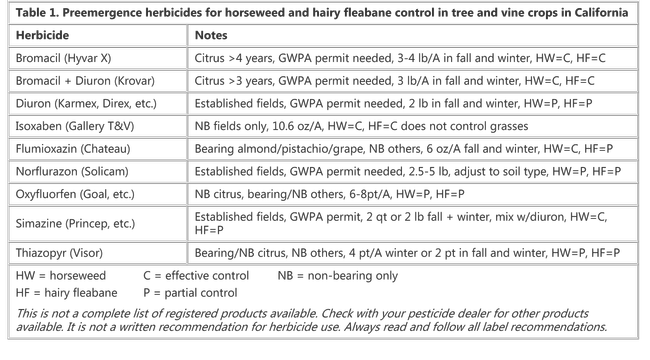As a farm advisor many growers will ask, “What is that in my grove- horseweed or fleabane?” These two weeds have been running rampant in Southern California, as well as other parts of the state and can be seen in every cropping system imaginable. Their population numbers can be alarming and can start to become troublesome to growers as they can easily become A challenge to control if left untreated. These two members of the of the Conyza family are particularly fond and thrive in permanent tree crop environments due to lack of tillage and lack of a crop rotation schedule due to the trees permanent status.
Horseweed (Conyza canadensis) and hairy fleabane (Conyza bonariensis) are summer annuals. The temperature and light requirements for germination, soil type preference, and depth of soil emergence of these two species are fairly similar and can usually be found growing side by side in a grove (Shrestha et al. 2008).
Biology
Horseweed and hairy fleabane plants are difficult to distinguish from each other until about the 12- leaf stage (Photo 2). Once the plants bolt, it is easy to differentiate the two species. When horseweed bolts, it sends up a single, or primary, vegetative stem that is erect with dark green leaves that are 4 inches long and are crowded together with an alternative arrangement on the stem. The stem is either smooth or covered with shaggy hairs (Shrestha et al. 2008).
Hairy fleabane, unlike horseweed, develops multiple lateral branching without a central stem, and has leaves that are much narrower with rigid hairs. The distance between leaves is greater in hairy fleabane than in horseweed. At maturity, horseweed can be10 feet tall, whereas hairy fleabane is usually 1.5 to 3 feet tall.
Photo 2. (Right) Seedlings of hairy fleabane (top) and, horseweed (bottom). (Photo: Shrestha et al. 2008).Horseweed and hairyfleabane seeds cannot survive more than ~3 years under field conditions. Controlling plants before they produce seed is critical for long-term management. Action should be taken when weeds are young, generally before they start producing seeds.
For more information regarding the differences between these two weeds, please see Shrestha et. al. (2008) UC ANR Publication: http://anrcatalog.ucanr.edu/pdf/8314.p
Management
Herbicides used in a grove are generally divided into two groups: 1) soil-applied (preemergence) herbicides that should be applied to fairly clean soil surfaces prior to weed emergence, and 2)foliar-applied (postemergence) herbicides that are applied after weeds have emerged (Futch and M.Singh 2014).Preemergence herbicides are generally applied two to three times per year, so the maximum amount of herbicide is present in the upper soil profile (0 to 2 inches) slightly before weeds emerge (Table 1). Herbicides applied too early, before weeds emerge, will not provide adequate weed control due to herbicide leaching or degradation on the soil surface or within the soil profile.Preemergence herbicides must also be incorporated into the soil (mainly by rainfall or irrigation) and are usually broadcast on the entire orchard floor as growers cannot predict where weeds will emerge (Rios et al. 2015). Growers using drip irrigation or micro-sprinkler irrigation have a difficult time adequately incorporatingpreemergence herbicides, so applications are generally scheduled around predicted rainfall (Rector et al. 1998). Consideration of soil type is important, as it may influence herbicide selection and rate used. Once weeds are under control, treatments should be applied every 2nd or 3rd year to maintain these conditions. Also, consideration to make split-applications in Oct./Nov. should occur, and again in Jan./Feb. if weed emergence is observed during these periods. If farming takes place in a groundwater protection area, a permit to use some of these products may be required
(refer to your county agricultural commissioner for regulations). It is important to acknowledge that while most of the effective materials on these weeds fall under specific regulations, they can still be used in many cases and should be considered.
Postemergent herbicides can be effective against these weeds, however application should occur when weeds are young (before the 14 leaf stage) and the appropriate dose according to the label should be applied. Tank-mixing may help (Preemergent + Postemergent maybe the most useful), especially if one is trying to control other weeds that are present in the grove. In general, when applying postemergent herbicides in a spray volume of 30 to 50 gallons per acre, adequate coverage of the weed foliage is necessary for good control (Shrestha et al. 2008). Caution should be used when using most postemergent herbicides around trees as many are broad-spectrum and do discriminate as to what they kill upon contact.
If one decides to mow weeds, s/he can try this approach before weeds produce seed. Also, weeds should not be mowed before applying herbicides. Mowing will simply stimulate additional branching from the crown of the plant and only delay seed production. In addition, mowing will also harden off these plants, making it almost impossible to control with a postemergent herbicide, as most postemergents are systemic and require movement by some type of circulation within the plant in order for effects to take place. The same goes for drought stressed weeds. These plants will not uptake herbicides in order to prevent loss of resources during a crises.
However, applicators beware! Relying on the same mode of action, such as glyphosate (Roundup) or same combinations of treatment after a few years increases the chance of selection for resistant populations. Rotating other effective products (even when you spot spray) when possible can prevent or delay herbicide resistance from occurring (Table 1, note: Indaziflam (Alion), is missing from table*At 5 to 6.5 oz./A, can provide up to 6 months of residual control in citrus, please see label). In the California Central Valley, populations of both weeds have now been shown to be resistant to glyphosate and paraquat. It has been predicted that we also have these two resistant biotypes here in Southern California, however screening research needs to be done to confirm.
In summary, weed management can be an expensive part of the total subtropical crop production program, but resources invested can provide significant economic returns. Weeds can impact cultural operations, tree growth, and yields by altering the spray pattern of low-volume irrigation systems, intercepting soil-applied chemicals (fertilizer and agricultural chemicals), reducing grove temperatures during freeze events, and interfering with pruning and harvest operations. The presence of weeds in groves can also affect insect populations. Weeds growing around tree trunks may also create a favorable environment for pathogens that infect the trunk and roots (Futch and Singh, 2010).
Scouting for weeds should be conducted in all areas in and near groves, including tree rows, row middles, water furrows, ditch banks, fence rows, and adjacent perimeter locations. These sites may receive different cultural practices which can facilitate the persistence and spread of different weed species. Small isolated weed patches should be managed before they spread to other areas of groves. Since weeds emerge all year long, weed surveys should be scheduled throughout the year, especially after rains or soil disturbances.
Preventive programs are often overlooked, but are an important component of cultural practices and are cost-effective. Practices, such as sanitation, spot spraying, and/or hand removal of weed escapes before they produce new seed are examples of prevention. While preventive programs may not stop the spread of all weed species, these practices may slow the spread of undesirable species, thereby reducing long-term weed control costs.


